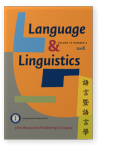Vol. 19:2 (2018) ► pp.333–375
Exploring the emergence of the postverbal sin1 先 in Cantonese
Sin1 先 as a function word in contemporary Cantonese encodes a number of grammatical and pragmatic meanings. As its most prominent feature in syntax, it predominantly occurs in the postverbal position while indicating the meaning of ‘first’. This paper explores the emergence of the postverbal sin1 先 ‘first’ in Cantonese. We first examine the word order typology on the element for ‘first’ in the languages and dialects of southern coastal China. In this linguistic area, the postverbal elements for ‘first’ in Chinese dialects are contact-induced by Tai-Kadai and Hmong-Mien languages; whereas sin1 先 ‘first’ in the mainstream Cantonese shows a stronger tendency to be placed in the postverbal position than its counterparts in other Chinese dialects. We then discuss the word order and semantic changes of sin1 先 from 1820s to 1960s based on Cantonese historical materials. Besides the pressure of language contact, the formation of the postverbal sin1 先 ‘first’ has been further triggered by the semantic motivation to formally differentiate the ‘precedent-subsequent’ polysemy within sin1 先 itself. In short, the emergence of the postverbal sin1 先 ‘first’ in Cantonese has been a two-stage process, dually driven by external and internal causes, respectively.
Article outline
- 1.Introduction
- 2.Postverbal elements for ‘first’ in an areal linguistics view
- 2.1Word order replication among languages of southern coastal China
- 2.2A disturbing question
- 3.Word order change of sin1 先: Preverbal versus postverbal
- 4.Semantic change of sin1 先: Precedent versus subsequent
- 5.Discussion
- 6.Conclusion
- Acknowledgements
- Notes
- Abbreviations
-
References
For any use beyond this license, please contact the publisher at [email protected].
